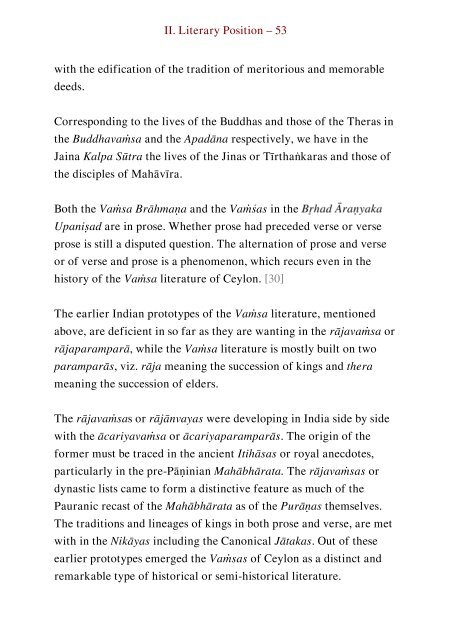On the Chronicles of Ceylon
A judicious appraisal of the various Chronicles that were written in Sri Lanka, assessing their chronology, literary and historical character.
A judicious appraisal of the various Chronicles that were written in Sri Lanka, assessing their chronology, literary and historical character.
- No tags were found...
Create successful ePaper yourself
Turn your PDF publications into a flip-book with our unique Google optimized e-Paper software.
II. Literary Position – 53<br />
with <strong>the</strong> edification <strong>of</strong> <strong>the</strong> tradition <strong>of</strong> meritorious and memorable<br />
deeds.<br />
Corresponding to <strong>the</strong> lives <strong>of</strong> <strong>the</strong> Buddhas and those <strong>of</strong> <strong>the</strong> Theras in<br />
<strong>the</strong> Buddhavaṁsa and <strong>the</strong> Apadāna respectively, we have in <strong>the</strong><br />
Jaina Kalpa Sūtra <strong>the</strong> lives <strong>of</strong> <strong>the</strong> Jinas or Tīrthaṅkaras and those <strong>of</strong><br />
<strong>the</strong> disciples <strong>of</strong> Mahāvīra.<br />
Both <strong>the</strong> Vaṁsa Brāhmaṇa and <strong>the</strong> Vaṁśas in <strong>the</strong><br />
Upaniṣad are in prose. Whe<strong>the</strong>r prose had preceded verse or verse<br />
prose is still a disputed question. The alternation <strong>of</strong> prose and verse<br />
or <strong>of</strong> verse and prose is a phenomenon, which recurs even in <strong>the</strong><br />
history <strong>of</strong> <strong>the</strong> Vaṁsa literature <strong>of</strong> <strong>Ceylon</strong>. [30]<br />
The earlier Indian prototypes <strong>of</strong> <strong>the</strong> Vaṁsa literature, mentioned<br />
above, are deficient in so far as <strong>the</strong>y are wanting in <strong>the</strong> rājavaṁsa or<br />
rājaparamparā, while <strong>the</strong> Vaṁsa literature is mostly built on two<br />
paramparās, viz. rāja meaning <strong>the</strong> succession <strong>of</strong> kings and <strong>the</strong>ra<br />
meaning <strong>the</strong> succession <strong>of</strong> elders.<br />
The rājavaṁsas or rājānvayas were developing in India side by side<br />
with <strong>the</strong> ācariyavaṁsa or ācariyaparamparās. The origin <strong>of</strong> <strong>the</strong><br />
former must be traced in <strong>the</strong> ancient Itihāsas or royal anecdotes,<br />
particularly in <strong>the</strong> pre-Pāṇinian Mahābhārata. The rājavaṁsas or<br />
dynastic lists came to form a distinctive feature as much <strong>of</strong> <strong>the</strong><br />
Pauranic recast <strong>of</strong> <strong>the</strong> Mahābhārata as <strong>of</strong> <strong>the</strong> Purāṇas <strong>the</strong>mselves.<br />
The traditions and lineages <strong>of</strong> kings in both prose and verse, are met<br />
with in <strong>the</strong> Nikāyas including <strong>the</strong> Canonical Jātakas. Out <strong>of</strong> <strong>the</strong>se<br />
earlier prototypes emerged <strong>the</strong> Vaṁsas <strong>of</strong> <strong>Ceylon</strong> as a distinct and<br />
remarkable type <strong>of</strong> historical or semi-historical literature.


















